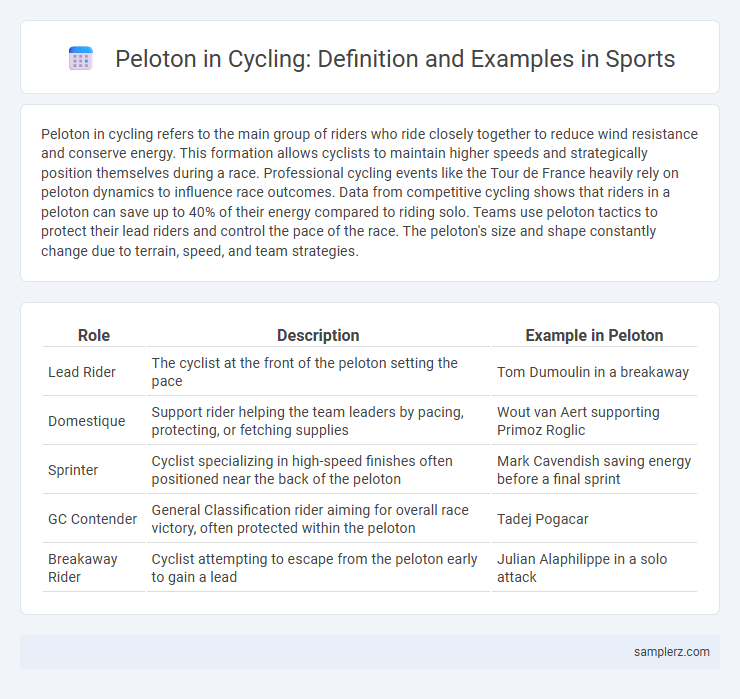Peloton in cycling refers to the main group of riders who ride closely together to reduce wind resistance and conserve energy. This formation allows cyclists to maintain higher speeds and strategically position themselves during a race. Professional cycling events like the Tour de France heavily rely on peloton dynamics to influence race outcomes. Data from competitive cycling shows that riders in a peloton can save up to 40% of their energy compared to riding solo. Teams use peloton tactics to protect their lead riders and control the pace of the race. The peloton's size and shape constantly change due to terrain, speed, and team strategies.
Table of Comparison
| Role | Description | Example in Peloton |
|---|---|---|
| Lead Rider | The cyclist at the front of the peloton setting the pace | Tom Dumoulin in a breakaway |
| Domestique | Support rider helping the team leaders by pacing, protecting, or fetching supplies | Wout van Aert supporting Primoz Roglic |
| Sprinter | Cyclist specializing in high-speed finishes often positioned near the back of the peloton | Mark Cavendish saving energy before a final sprint |
| GC Contender | General Classification rider aiming for overall race victory, often protected within the peloton | Tadej Pogacar |
| Breakaway Rider | Cyclist attempting to escape from the peloton early to gain a lead | Julian Alaphilippe in a solo attack |
Understanding the Peloton: Definition and Importance in Cycling
The peloton in cycling refers to the main group of riders who stay closely together to reduce air resistance and conserve energy. This collective formation allows cyclists to draft off each other, increasing overall efficiency and strategic positioning during races. Understanding the peloton's dynamics is crucial for both competitive tactics and endurance management in professional cycling events.
How the Peloton Functions in Professional Races
The peloton in professional cycling functions as a tightly-packed group of riders working strategically to reduce wind resistance and conserve energy, allowing cyclists to maintain higher speeds collectively. Team tactics within the peloton involve drafting, coordinated pacing, and controlling the race tempo to position key riders optimally for sprints or breakaways. This dynamic formation enhances efficiency and plays a critical role in race outcomes by managing efforts over long distances and responding quickly to competitors' moves.
Energy Conservation Strategies Within the Peloton
Riders within a peloton conserve energy by drafting closely behind teammates, reducing aerodynamic drag by up to 40%. This formation allows cyclists to maintain higher speeds with less effort, optimizing oxygen use and muscle fatigue management. Strategic positioning in the peloton enhances endurance and accelerates recovery during long-distance races.
Famous Peloton Moments in Tour de France History
The 2012 Tour de France featured one of the most dramatic peloton moments when Bradley Wiggins broke away from the pack to secure his historic win as the first British cyclist to claim the yellow jersey. During the 2018 edition, the peloton's strategic sprint finishes on flat stages highlighted the intense competition between top sprinters like Peter Sagan and Marcel Kittel. Another memorable peloton moment occurred in 2020 when Tadej Pogacar leveraged teamwork within the peloton to execute a decisive attack on the final mountain stages, securing the overall victory.
Teamwork and Communication Inside the Peloton
Effective teamwork and communication inside the peloton are crucial for maintaining optimal speed and positioning during cycling races. Riders use hand signals, body language, and verbal cues to coordinate drafting, execute strategic shifts, and protect teammates from wind resistance. This collective effort enhances overall performance, conserves energy, and increases the chances of success in competitive cycling events.
Breakaways vs. Peloton: Tactics and Outcomes
Breakaways in cycling involve a small group of riders attempting to distance themselves from the larger peloton, often aiming for early stage victories or strategic advantages. The peloton, leveraging aerodynamic drafting and collective pacing, efficiently conserves energy to reel in breakaway attempts during critical race phases. Successful breakaways depend on precise timing, individual strength, and team support, while the peloton's coordinated chase typically dictates overall race dynamics and finishing outcomes.
The Psychology of Riding in the Peloton
Riding in the peloton leverages psychological principles such as social conformity and collective motivation, enhancing cyclists' performance by reducing perceived exertion and fostering teamwork. The aerodynamic advantage gained from drafting behind others in the group not only conserves energy but also boosts riders' confidence and strategic aggression. Understanding group dynamics within the peloton is crucial for riders to make split-second decisions that impact race outcomes and overall endurance.
Safety and Crash Risks in a Dense Peloton
Riding in a dense peloton significantly increases the risk of crashes due to limited reaction time and close proximity among cyclists. Sudden movements or loss of control by one rider can trigger a domino effect, leading to multi-rider pileups. Proper communication, steady pacing, and heightened situational awareness are essential to minimize safety hazards in high-density group cycling.
Technology and Data Analytics Used in the Peloton
Peloton leverages advanced technology including power meters, heart rate monitors, and real-time performance tracking to optimize cyclist training and enhance user engagement. Data analytics processes metrics such as cadence, resistance, and output to provide personalized workout adjustments and detailed performance insights. Integration of AI algorithms enables predictive coaching and adaptive workout programming, ensuring cyclists can continuously improve their endurance and strength.
Key Cyclists Known for Dominating the Peloton
Tadej Pogacar consistently dominates the peloton with his aggressive climbing and time-trial skills, often dictating race dynamics in grand tours. Wout van Aert excels in various terrains, blending sprinting power and endurance to control peloton pace during crucial moments. Julian Alaphilippe's explosive attacks and tactical intelligence make him a key rider who frequently breaks away from the peloton in one-day classics and stage races.

example of peloton in cycling Infographic
 samplerz.com
samplerz.com